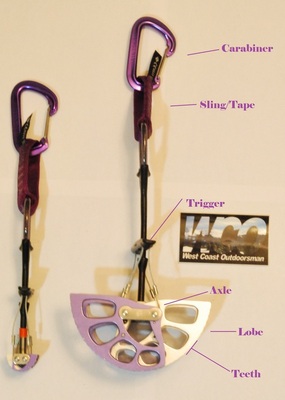Spring Loaded Camming Devices (SLCD), and How to Place Them

Overview
Cams or camelots are a trad climbers tool of choice when it comes to quick and secure rock protection. They can expand and contract to fit your exact crack size, then are removed just as easily. Cams are known as active protection because they are not one solid piece of metal, but instead have many moving parts. After placement, a weighted SLCD from a fall will force the lobes to press outward into your crack further engaging the teeth. In turn the grabbing action of the teeth will create a solid point to help stop a fall. Cams range in price from sixty to hundreds of dollars and come in many sizes.
Parts of a Cam
There are many moving parts that go into making cam. High quality cams are made both lightweight and strong. Cams are mostly made up of aluminum with sturdy nylon webbing for easy attachment to your carabiner or quickdraw. The points of contact to the rock are called teeth, which are located on the lobes. (This C4 camelot, made by black diamond has 4 lobes. Two are purple and two are silver.) The lobes are activated by the trigger which when pulled rotates them around the axle.
Cams or camelots are a trad climbers tool of choice when it comes to quick and secure rock protection. They can expand and contract to fit your exact crack size, then are removed just as easily. Cams are known as active protection because they are not one solid piece of metal, but instead have many moving parts. After placement, a weighted SLCD from a fall will force the lobes to press outward into your crack further engaging the teeth. In turn the grabbing action of the teeth will create a solid point to help stop a fall. Cams range in price from sixty to hundreds of dollars and come in many sizes.
Parts of a Cam
There are many moving parts that go into making cam. High quality cams are made both lightweight and strong. Cams are mostly made up of aluminum with sturdy nylon webbing for easy attachment to your carabiner or quickdraw. The points of contact to the rock are called teeth, which are located on the lobes. (This C4 camelot, made by black diamond has 4 lobes. Two are purple and two are silver.) The lobes are activated by the trigger which when pulled rotates them around the axle.

How to place a cam
Placing a cam is a fairly easy process but requires a watchful eye to make sure it is done correctly. First look for a crack that has parallel sides and solid rock that is not "chossy" or loose. Next decide which size cam is appropriate to place. The cam you choose can not be fully cammed opened or closed.
Placing a cam is a fairly easy process but requires a watchful eye to make sure it is done correctly. First look for a crack that has parallel sides and solid rock that is not "chossy" or loose. Next decide which size cam is appropriate to place. The cam you choose can not be fully cammed opened or closed.


